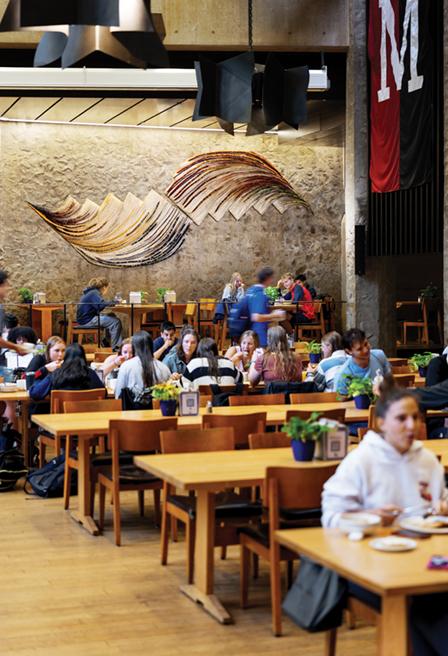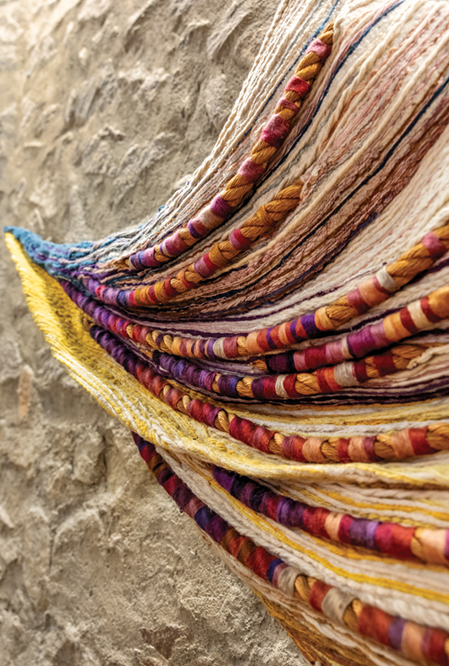
Bob Handelman
A fiber sculpture by artist Janet Kuemmerlein has adorned the back wall of the Morse College dining hall for many decades. Mary Christ, campus art collection registrar, wants to know how—and when—it got there.
View full image

Bob Handelman
A fiber sculpture by artist Janet Kuemmerlein has adorned the back wall of the Morse College dining hall for many decades. Mary Christ, campus art collection registrar, wants to know how—and when—it got there.
View full image

Bob Handelman

Bob Handelman
We’re asking Morse alumni, fellows, and friends to reach into their memory banks to help us solve one of the many mysteries of Yale’s campus art collection.
When Morse College staff, concerned about the condition of the fiber sculpture adorning the back wall of the Morse dining hall, contacted this author about repairing and conserving it, no one could quite remember when it was first installed, but it was clear that after many years in a student dining hall, the artwork needed some care.
So, what is this sculpture, who created it, and how and when did it come to Morse? We found one clue stitched into the lower left side of the artwork, “Kuemmerlein.” The name of the artist, perhaps? Interviews, articles, and the catalogs of several notable museums and galleries led us to the story of a remarkable artist.
Janet Rozmus was born in 1932 in Detroit, Michigan, and grew up in an eastern European immigrant community. A self-described “artist since kindergarten,” Rozmus studied at the Detroit Society of Arts and Crafts and graduated in 1952 from Cranbrook Academy of Art in Bloomfield Hills, Michigan. The following year, she married Robert L. Kuemmerlein, and they soon moved to the Kansas City area.
Robert died just a few years later, in 1960, leaving Janet Kuemmerlein a young widow with four children to support. She knew that she could make a living as an artist, but others weren’t so sure. “I was sitting with a group of men who were helping me, a stockbroker, a lawyer, a banker, and I said, ‘Oh don’t worry about me, I’m a good artist,’ and of course, they all rolled their eyes,” Kuemmerlein told artist Rachelle Gardner-Roe in a March 2017 interview. “Later one of the lawyers came to my house and said, ‘You know, we didn’t think you could do it, but you did.’”
Though trained in painting and sculpting, Kuemmerlein said that when she set up her home studio, she focused on fiber art to avoid bringing harsh chemicals into her home. Her decision coincided with the dawn of the fiber art movement.
Fiber arts had previously been dismissed as mere handicraft by critics. But by the 1960s, artists—primarily women—were experimenting with thread and fabric, technique, and style. Their work was increasingly abstract, conceptual, and three-dimensional. Fiber art was finally receiving the respect it deserved.
As Kuemmerlein’s career progressed, the art world evolved as well. The 1970s and 1980s was a period of significant investment in public art, and indeed some of Kuemmerlein’s most famous works were commissions for public buildings, including the fifty-foot-long fiber mural, Arctic Echoes (1986), at the Z. J. Loussac Public Library, in Anchorage, Alaska.
Learning about Janet Kuemmerlein’s life and career has been fascinating, but we still haven’t determined how the fiber sculpture came to be in Morse. Could Kuemmerlein have crossed paths with Eero Saarinen ’34BFA, architect of Morse and Stiles colleges and son of Cranbrook’s own Eliel and Loja Saarinen? It’s possible, though Eero Saarinen died in 1961, when Kuemmerlein’s career was just getting started. Did she know Vincent Scully ’40, ’49PhD, famed architectural historian and head of Morse from 1969 to 1975? Maybe.
Though Kuemmerlein’s current health does not allow for an interview, her children believe that the Morse fiber sculpture dates to about 1980. There are photographs of the Morse dining hall from the 1990s in which Kuemmerlein’s sculpture is visible.
While Kuemmerlein’s story was unfolding, the Morse sculpture was receiving top-tier conservation care. First, it was deinstalled and transported to West Campus, where it spent three days in a special freezer, eliminating the presence of any multilegged stowaways. Next, a Yale Art Gallery conservation fellow vacuumed the sculpture. Finally, the conservation firm Holbrook & Hawes spent a week removing stains, repairing loose threads, replacing the padding and lining, and resealing the wooden support, thus restoring the fiber sculpture to its original glory.
Now that the piece has been reinstalled in the Morse dining hall, we are asking the Morse community for their recollections of this vibrant artwork. Do you have historic photos of the dining hall? Do you remember when the fiber sculpture was installed? We look forward to hearing from you!
 loading
loading